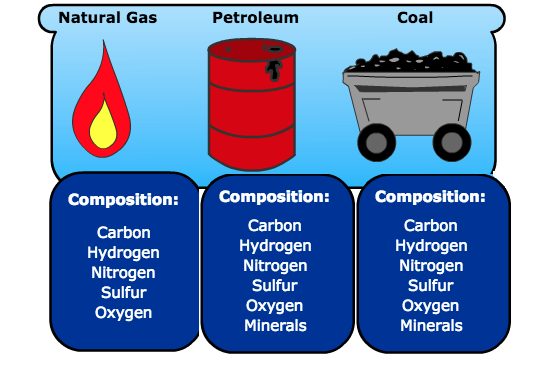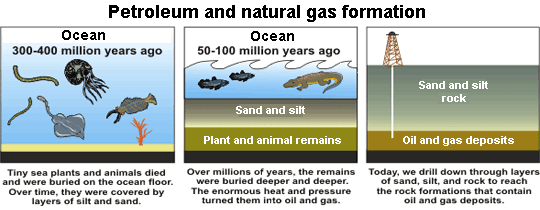Describe How Coal Oil and Natural Gas Are Used
Thus oil is burned to heat water. Who are the experts.

Learning Geology Formation Of Coal Oil And Gas
The accumulation of layers of debris creates a dense material called peat that transforms into coal.

. Oil otherwise known as crude is a thick black liquid composed primarily of hydrogen and carbon. Natural Gas-The impacts and improvements Final verdict. These organisms break down the released oil into the sediment which depending on the type of sediment traps the oil.
Where are the largest reserves in the United States for these three sources of energy. Coal comes mainly from dead plants which have been buried and compacted beneath sediments. Due to recent rises in greenhouse effects many organizations worldwide that advocate for a clean environment have launched campaigns that aim to reduce the amount of carbon emission to the environment.
They were generated from the remains of deceased species over millions of years. Coal oil and natural gas are examples of fossil fuels. Natural gas is a naturally occurring hydrocarbon mixture consisting primarily of methane but commonly including varying amounts of other higher alkanes and sometimes a small percentage of carbon-dioxide nitrogen and hydrogen sulphide.
CH_ 20 9 210 g CO2 g - Draw the Lewis structure for each structure in this reaction. The different fossil fuels will expose you to different benefits and negative results. I can describe how oil and gas form.
Examples of fossil fuels include natural gas oil and coal. Natural gas is also formed during those processes but it can also be generated relatively quickly by organic material decomposition as in municipal landfills and waste. This video describes how fossil fuels such as oil gas and coal are formed and where they can be found.
Describe the processes that resulted in the formation of oil and natural gas Oil and natural gas are formed from marine organisms that accumulate in the ocean floor and are buried in sediment. Environmental for each of the following. Power plants that burn oil to produce electricity are called oil-fired plants.
Coal and oil form from deposits of animal and vegetable matter deep in the ground at conditions of high pressure over many years. Describe how coal oil and natural gas form how these fuels are used and how using each fuel affects the environment. Let us discuss how coal oil and natural gas are formed and how using each could affect the environment.
Many fleet vehicles use compressed natural gas as an alternative to liquid gasoline. The use of coal as a fuel predates recorded history. Coal was formed from dead trees and other plant debris.
Oil was discovered as a solid material between layers of sedimentary rock such as shale at first. The oil and gas then migrates through the pores in the rocks to eventually collect in reservoirs. Definition and properties of natural gas Definition.
Describe how coal oil and natural gas form are used and how they effect the enviroment Oil and Natural gas are both formed from marine organisms decay being buried for long periods of time. Use of coal - The vast majority of wolds fossil fuel reserves consist of coal. This equation shows the combustion of methane.
Once these resources are used up they cannot be replaced which is a major problem for humanity as we are currently dependent on them to supply most of our energy needs. The clean burning properties of natural gas have contributed to increased natural gas use for electricity generation and as a transportation. Coal was used to run furnaces for the melting of metal ore.
15 pts Coal is formed from deposits of plant debris over millions of years usually from swampy areas. Oil is used to produce fuels chemicals. We review their content and use your feedback to keep the quality high.
Assignment 3 NRES 1 In your own words describe how coal oil and natural gas formed. History of fossil fuels. The economic pillar of.
I can describe how coals forms. As a matter of operation they generally operate similar to fossil-fueled counterparts the coal-fired and natural-gas-fired plants. I can explain recent trends in US fossil fuel production.
Dead sea organisms were used. Global Energy Demand Is Growing. Coal oil and natural gas.
The branch of geology that has the greatest economic importance worldwide is the study of fossil fuels coal oil and natural gas. We set up side-by-side comparisons of what these materials are made of how they develop and the settings where. Describe at least three concerns for each pillar of sustainability economic social and.
Describe how fossil fuels are used to produce electricity and explain how an electric generator works. Heat and pressure in the absence of oxygen transform the decomposed material into tiny pockets of gas and crude oil. Coal is a solid oil is a liquid and natural gas is a vapor gas.
The places where the original organic material forms can be understood by studying depositional. Experts are tested by Chegg as specialists in their subject area. They form by diagenetic processes that alter material made up of the remains of organisms.
Formation of coal oil and gas. Fossil fuels include crude oil coal and natural gas. Natural gas is a very important fossil fuel because it is easy to.
Nonrenewable energy resources include coal natural gas oil and nuclear energy. Coal formation - Coal is formed by heating the remains of plants that lived in swamps hundreds of millions of years ago. First into a waxy material known as kerogen which is found in oil shales and then with more heat into liquid petroleum and with even more heat into natural gas.
Global energy demand grew by 8 from 2008- 2012 Demand projected to increase by 37 by 2040 Development of renewables is being outpaced by energy demand growth. Commercial exploitation of petroleum largely as a replacement for oils. Natural gas is mainly composed of methane CH.
Fossil fuels include coal oil and natural gas to name a few. About 117 pounds of CO 2 are produced per million British thermal units MMBtu equivalent of natural gas compared with more than 200 pounds of CO 2 per MMBtu of coal and more than 160 pounds per MMBtu of distillate fuel oil.

Learning Geology Formation Of Coal Oil And Gas

Fossil Fuel Elements Egee 102 Energy Conservation And Environmental Protection

No comments for "Describe How Coal Oil and Natural Gas Are Used"
Post a Comment